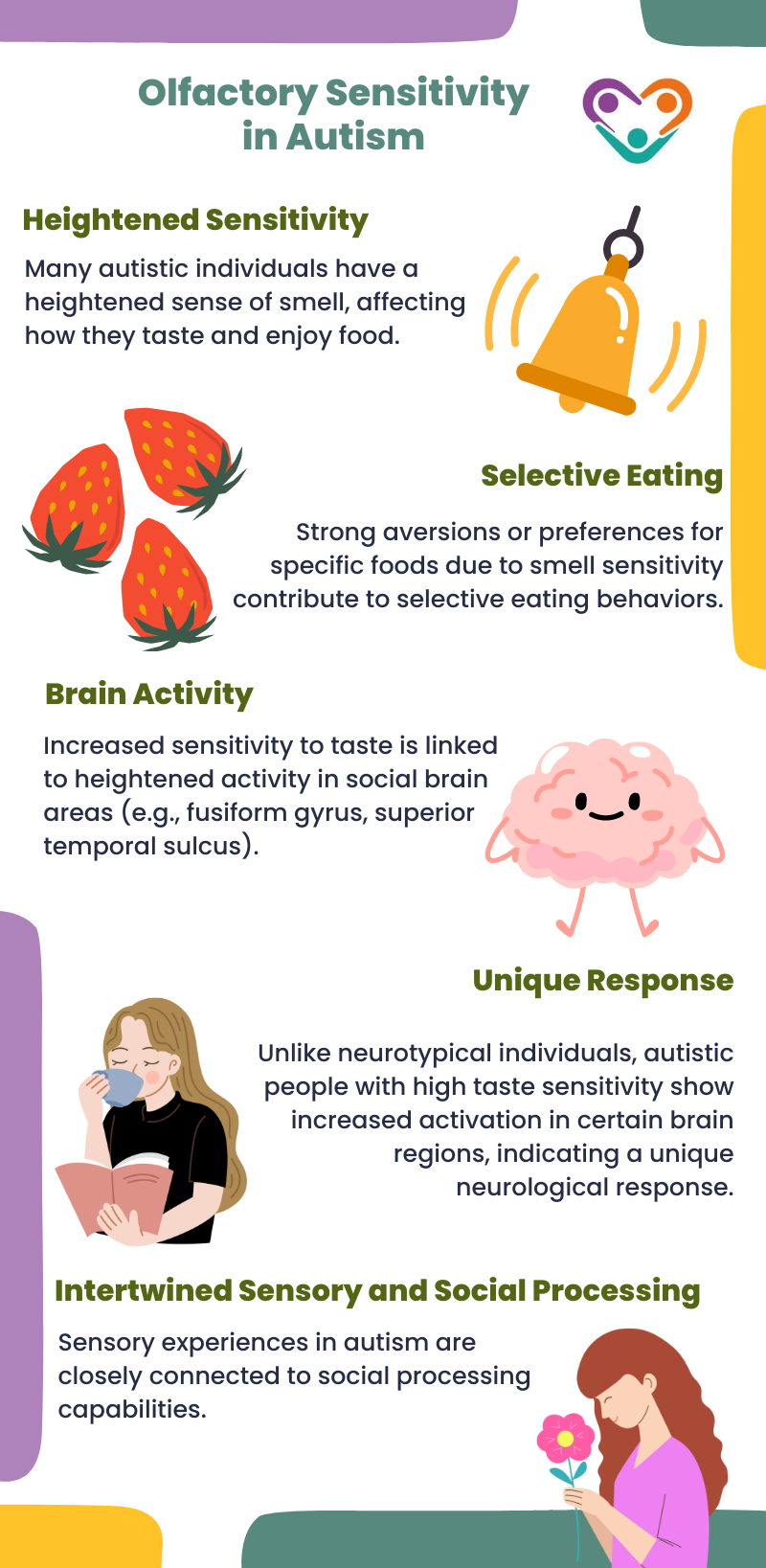Taste sensitivity is a common trait in many individuals with autism, often leading to selective eating behaviors. For parents and caregivers, recognizing these sensitivities is essential for ensuring a balanced and nutritious diet for their children. This article will explore the various aspects of taste sensitivity in autism, including taste identification challenges, the role of olfactory sensitivity, food preferences, and the impact on brain response.

Taste Identification Challenges
One significant challenge for individuals with autism is accurately identifying different tastes. Research has shown that children and adolescents with high-functioning autism often struggle to correctly identify sour and bitter tastes compared to their typically developing peers. This difficulty is less pronounced when it comes to identifying sweet and salty tastes, where their performance tends to be similar to that of non-autistic individuals.
Interestingly, studies have found that the taste detection thresholds—the minimum concentration of a taste that an individual can detect—do not differ significantly between autistic and non-autistic individuals. This indicates that the ability to sense these tastes is intact, but the challenge lies in the processing and identification of these tastes. Researchers believe that the root of the problem may be cortical dysfunction.
Addressing taste sensitivity involves creating a supportive environment that promotes healthy eating habits and ensures proper nutrition. One effective approach is to explore sensory strategies, such as tactile sensory activities, which can help desensitize individuals to certain textures and flavors. Additionally, considering individual food preferences and gradually introducing new tastes in a non-threatening manner can be beneficial.

Olfactory Sensitivity in Autism
Olfactory sensitivity, or heightened sensitivity to smells, is a common sensory issue for individuals with autism. This sensitivity can significantly impact taste perception and has been linked to social impairments, adding complexity to the challenges faced by autistic individuals.
Impact on Taste Perception
Research indicates that individuals with autism often struggle with olfactory identification, meaning they have difficulty recognizing and distinguishing between different smells. This challenge directly affects their taste perception since smell is integral to how we experience and enjoy food. When the ability to identify smells is compromised, it can lead to altered taste experiences and difficulties in distinguishing flavors.
The relationship between olfactory sensitivity and taste perception in autism is complex. Some autistic individuals may have heightened sensitivity to certain smells, causing them to develop strong aversions or preferences for specific foods. These difficulties contribute to the selective eating behaviors commonly observed in individuals with autism. For example, one might refuse foods with unusual textures, sticking instead to a limited range of familiar foods.
Relationship to Social Impairment
Autism’s olfactory sensitivity is linked to social impairments in addition to being a sensory problem. Research has demonstrated that autistic adults who are highly responsive to taste experience something sweet or look at pictures of food, their brain activity in social areas increases. This implies that their taste sensitivity affects brain areas like the fusiform gyrus and the superior temporal sulcus that are involved in processing social information.
Interestingly, this increased activation in brain regions differs from what is observed in neurotypical individuals. In non-autistic controls, higher taste sensitivity is linked to decreased activation in these same brain areas. This contrast highlights a unique neurological response in individuals with autism, indicating that their sensory experiences are deeply intertwined with their social processing capabilities.
Sensory Sensitivity and Food Selectivity
When it comes to taste sensitivity in individuals with autism, food preferences can be quite challenging for parents and caregivers to manage. Many children and adults on the autism spectrum are extremely sensitive not only to the flavor of foods but also to their color, smell, and texture. This heightened sensory sensitivity can significantly contribute to food selectivity, where individuals develop strong preferences for a narrow selection of foods.
Sensory Sensitivity Leading to Food Selectivity
Sensory sensitivities can cause individuals with autism to have exaggerated and intense food preferences. Just as they may focus intensely on specific interests, they may also have very specific requirements for their food. This can include preferences for certain textures or aversions to particular colors or smells.
A common pattern is a strong preference for carbohydrates and processed foods, often coupled with a reluctance to eat fruits and vegetables. This preference can be attributed to various sensory factors, including the texture or mouthfeel of certain foods. However, this tendency to favor carbohydrates over other food groups can potentially lead to nutritional deficiencies.
The strong need for sameness, common in individuals with autism spectrum disorder (ASD), can make introducing new foods a significant challenge. Changes in the presentation of familiar foods, or the presence of unexpected foods on their plates, can be distressing, similar to how a substitute teacher can be unsettling for children with autism.
Strategies for Managing Food Selectivity
It is important for parents and other caregivers to approach food selectivity with patience and understanding. People with autism can broaden their food choices with the assistance of visual aids, social modeling, and gradual introduction to new foods. For instance, the introduction process can go more smoothly if images are used to describe new foods.
Communication and collaboration with the individual’s healthcare team are essential to address any nutritional concerns and ensure that dietary needs are met. A registered dietitian can provide valuable guidance and support in developing strategies to broaden the individual’s food repertoire while maintaining a balanced and nutritious diet.
Factors Influencing Food Selectivity
Food selectivity is a prevalent challenge among individuals with autism, influenced by various factors that parents and caregivers need to understand to provide appropriate support. Two key factors affecting food selectivity in autistic individuals are sensory issues and their impact on nutritional adequacy.
Role of Sensory Issues
Sensory issues like tactile defensiveness and oral defensiveness play a crucial role in food selectivity. Tactile defensiveness refers to an aversion to certain touch-related stimuli, while oral defensiveness involves similar reactions to oral sensations. These issues can make it difficult for individuals with autism to tolerate various food textures.
Addressing sensory issues related to food selectivity involves implementing tactile sensory activities and other sensory integration techniques. These activities can help individuals with autism gradually become more comfortable with different textures and sensations, ultimately expanding their food choices.
Impact on Nutritional Adequacy
Food selectivity in individuals with autism can significantly impact nutritional adequacy. Research shows that children with autism often have higher levels of food selectivity and consume fewer foods compared to typically developing children. They tend to prefer low-texture foods like pureed and consume fewer varieties within each food group.
While findings on the nutritional adequacy of individuals with autism vary, some studies report inadequate nutrient intakes in children with ASD. However, not all individuals may experience deficiencies. Ensuring proper nutrition requires working with healthcare professionals who can assess the individual’s specific dietary needs and develop a personalized plan.

Brain Response to Taste Sensitivity
Several brain regions have been identified to show increased activation in individuals with autism who have heightened taste sensitivity. Among these regions are the superior temporal sulcus and the fusiform gyrus, both involved in processing social information and facial recognition, suggesting a link between taste sensitivity and brain areas implicated in autism.
Interestingly, individuals with autism who have more intense taste sensitivity also display a greater brain response to food pictures. This response extends beyond the physical act of tasting food and encompasses a conceptual level in the brain. In contrast, controls with greater taste sensitivity show a weaker response to food pictures in these brain areas.
While individuals with autism who have higher taste sensitivity exhibit increased brain activity in regions associated with social information processing, controls with greater taste sensitivity show decreased activation in the same brain regions. This reversed relationship suggests a potential neurological distinction related to taste perception in autism.
Understanding the intricate relationship between taste sensitivity, brain activation, and social brain areas is essential for gaining insight into the sensory experiences of individuals with autism. This knowledge can inform the development of targeted interventions and support strategies. By exploring how taste sensitivity impacts brain function, researchers can better develop effective ways to address these issues.
Research continues to shed light on the neurological basis of sensory issues in autism, offering hope for more targeted and effective therapies in the future. By recognizing and addressing sensory processing difficulties, we can improve the quality of life for individuals with autism and their families. If you’re seeking specialized ABA therapy in New Jersey, Indiana, Georgia, and New York, Golden Care offers comprehensive services tailored to meet the unique needs of each individual. Contact us to learn more or book a consultation today.
Sources:
- https://www.ncbi.nlm.nih.gov/pmc/articles/PMC2063511/
- https://www.thetransmitter.org/spectrum/autism-food-quirks-show-social-brain-areas/
- https://onlinelibrary.wiley.com/doi/full/10.1002/erv.2931
- https://www.autismspeaks.org/expert-opinion/what-it-about-autism-and-food
- https://www.ncbi.nlm.nih.gov/pmc/articles/PMC3601920/



